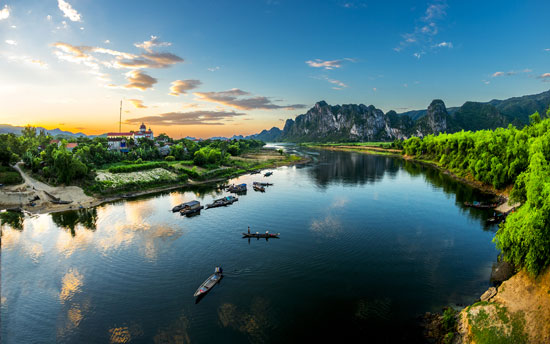No 1, Vol.6, January – February 2016

There are 213 rivers in Vi?t Nam but Gianh river is the only one that lies completely inside one province – Qu?ng Bình. It’s Qu?ng Bình’s biggest river, so the locals call it the Mother river, the province’s natural symbol.
Rugged upper reaches
Mother river takes its waters from 2017m-high Cô Pi mountain of the mighty Tr??ng S?n range and flows northward, then changes its direction toward the South-East, zigzaging through districts of Minh Hóa, Tuyên Hoá and Qu?ng Tr?ch to reach East Sea.

Almost all tributaries of this 160km-long river come from the great Tr??ng S?n range or the 99 legendary limestone mountains. These big and small streams have flowed for millions of years through easy to- erode limestone terrain, thus creating scenic caves such as Minh C?m, L?c S?n. In Nov. 2009, a wonderful multilevel cave was discovered 50m beneath the Tuyên Hóa section of the river.
The upper 70-80 km long parts of river Gianh, winding among mountains, have many perilous cascades. Further down, the flow grows bigger and bigger, and the scenery on the banks also changes dramatically.

The riverbed is very steep near its sources. Gianh river’s average steepness is 19.2%. Therefore, during the flood season from Sept. to Nov., the flow is very violent. Qu?ng Bình people say only those who have witnessed the crest of its floods know its power and ferocity.
After the rainy season, Gianh river waters quickly become clear and peaceful. One of the most beautiful and scenic section of the Mother river is the part that crosses Qu?ng Tr?ch district, having an average width of 100m and 5 little isles. At about 10 km from its estuary, the river’s water begins to taste salty, as it mixes with sea water.

A divine river
In 1069 under Marshal Lý Th??ng Ki?t’s command, Lý dynasty’s army defeated Champa army on Gianh river and took back Qu?ng Bình land for the Great Vi?t. Since then Gianh river became a vital military frontier for Great Vi?t’s southward expansion.
In 1406, 800 thousand Chinese Minh troops invaded Great Vi?t. River Gianh again witnessed many bloody battles between the two countries’ armies, as recorded in history.
In Jan 1471, leading his army fom the Th?ng Long (today’s Hà N?i) capital down South, King Lê Thánh Tông stopped his flotillas on Gianh river. Seeing the perilous rugged terrain on both sides, the King thought it was a divine river.

From 1570 to 1786, Gianh river witnessed many wars in the power struggle between the Tr?nh and Nguy?n feudal lords of Great Vi?t. Those civil wars have left many vivid traces, such as Th?y Rampart, Qu?ng Bình border gate, and some citadels.

After each war, more Vi?t people from the North come to settle on both sides of Gianh river, especially around the royal military outpost which today is Ba ??n town. The new settlements continually expanded, covering both banks of Gianh river. Rice cultivation and many other trades followed suit. Today’s villages on both sides of the river still practice the trade of those pioneering settlers.

The oldest trade villages concentrate in Qu?ng Tr?ch district and Ba ??n township. In Qu?ng Tr?ch people grow rice, plant cotton and weave fabrics, make cone hats and do meshwork. Whereas Ba ??n, the old royal military outpost, has carpentry, blacksmithing, carving and foundries (Hòa Ninh village of Qu?ng Hòa commune.)
One of the most famous villages along Gianh river is L? S?n village of V?n Hóa commune, Tuyên Hóa district. It leans on the 99 pensive rocky mountains, facing the river, looking like a heavenly paradise on earth.

Moreover, history recorded that a century ago, L? S?n was the top among 8 villages that had the highest learning spirit and success of Qu?ng Bình.
The most popular dish of the people of Qu?ng Bình in general and along Gianh river in particular is small mussels fried with piper lolot leaves or young jackfruit, sandwiched in dry rice pancake. Second is simmered brined goby. These are the two simple food items that Qu?ng Bình natives carry the taste of their tongue all their life, no matter where they go and what other tastes of life they experience.n
,,
,,

